The U.S. Department of Education (ED) invited schools to enter the CTE Makeover Challenge by submitting a design for a CTE makerspace.
A makerspace is an environment or facility that provides resources, materials, and equipment for students to conceive, create, and collaborate through making. Making refers to a hands-on learning approach that encourages students to imagine, create, and tinker through the process of manufacturing, testing, and demonstrating their ideas. Through making, educators enable students to immerse themselves in problem-solving and the continuous refinement of their projects while learning essential 21st-century career skills, such as critical thinking, planning, and communication. ED sought models of CTE makerspaces across a wide range of facility types, such as classrooms, libraries, and mobile spaces, that it could share with educators to encourage the creation of affordable, scalable, and replicable makerspaces.
All eligible schools were invited to participate in the CTE Makeover Bootcamp, a 6-week program that provided resources and expertise in makerspace design and planning. $200,000 in cash and other prizes were distributed to 10 prize winners to turn their vision for a makerspace into a reality. Prize winners submitted a video tour of their constructed makerspaces and compiled an online portfolio of materials for use in the CTE Makerspace Showcase at the World Maker Faire in New York City in October 2016.
See the full Challenge Rules, Terms, and Conditions here (PDF).

At a Glance
Awards
$200,000
10 finalists received $20,000 and a share of donated in-kind prizes valued at $375,000
Schedule
Mar - Apr 2016: Open Submissions
Apr - May 2016: Bootcamp (open)
Jun 2016: Winner Announcement
Jun - Sep 2016: Makerspace Build out
Oct 2016: Winner Showcase at World Maker Faire
Submission
A CTE makerspace blueprint with designs and plans to turn the school’s vision for a makerspace into a reality.
See full Submission Form here (PDF).
OCTAE Contact
Jenny Lambert
Jenny.Lambert@ed.gov
(202) 987-1304
Finalists
On June 17, the 10 CTE Makeover Challenge prize winners were announced at the White House Champions of Change for Making event. Each winning school received $20,000 and a share of in-kind prizes donated by sponsors and valued at $375,000.
From mobile makerlabs to autoshop libraries to entrepreneurship hubs, these 10 makerspaces serve as exceptional models for all schools working on developing their own making programs. Take a look at these exemplary makerspaces from schools across the nation below:
Burlington, VT
Built from the ground up in a space that is currently empty, Studio B (Burlington) encourages students to work in an interdisciplinary fashion with all CTE programs. Welders working with artists, 3D modelers working with the aviation students, and Early Childhood Ed students working with programming and robotics students create opportunities for students to learn across disciplines. The program’s core elements are a part of every student’s personalized learning plan. This new facility and its instructors, students, and members are catalysts in renovating Burlington Technical Center’s adult education program.
Learn more about Burlington Technical Center’s makerspace:
Washington, D.C.
Capital City Public Charter School’s makerspace is the centralized hub of experiential learning, innovation, and 21st century skill building in the school. It is a joyous, inspiring space, allowing their 659 students in 5th-12th grade to create physical or digital objects that bring concepts to life. The makerspace will set Capital City apart as a place not only to learn, but also as a place for students to gain independence, creativity, and STEAM skills.
Learn more about Capital City Public Charter School’s makerspace:
Chicago, IL
The Carl Schurz High School makerspace will be an inviting and open space where students can play, express, and cultivate their curiosity in the DIY culture.
Learn more about Carl Schurz High School’s makerspace:
- Q&A with the Team (PDF)
- Makerspace Design (PDF)
- Carl Schurz High School Makerspace Video [LINK PENDING]
- Video reaction to Prize Winner Announcement [LINK PENDING]
Piedmont, MO
Clearwater High School’s CTE Makeover Challenge makerspace project, “Transforming Library Space for School and Community Engagement,” presents a flexible, mobile makerspace as the means for collaborative work between the school and community. Students and community members will work together, sharing knowledge, resources, and career networking. Students will be motivated with access to a wide variety of lab stations, allowing application of academic skills and development of creativity and innovation, while engaging in purposeful projects that solve “real world challenges” within the community. The makerspace will serve as a launchpad into high tech careers, introducing students to robotics, computers, engineering/electrical design, video/audio editing/production, graphic arts, and other creative processes.
Learn more about Clearwater High School’s makerspace:
Sterling, VA
The Dominion High School makerspace is an updated CTE classroom paired with a set of mobile maker carts. Students in the makerspace will have access to the latest in digital fabrication machines and electronics in order to create public products for the world that solve authentic challenging problems. The maker carts will be spread out around the school providing access to maker tools in every classroom.
Learn more about Dominion High School’s makerspace:
Austin, TX
Reagan Early College High School’s makerspace is a place where creative freedom meets engineering technology. There are two connected spaces: (1) a computer lab where students can explore 3D modeling and computer programming and (2) an adjacent workspace where students can 3D print their creations, machine their ideas out of wood, or assemble electrical circuits and mechanical systems. It is a place where students feel welcome and part of a community of innovators and continuous learners.
Learn more about John H. Reagan Early College High School’s makerspace:
Pacific Palisades, CA
The Pali STEAM Shop is a makerspace with a mission of social justice: to provide equitable access to the tools of innovation. Our vision has been to open a classroom that pays homage to traditional shop class, aggressively embraces innovation, and ensures that underrepresented students are active and engaged leaders in the program.
Learn more about Palisades Charter High School’s makerspace:
San Antonio, TX
The Roosevelt High School CTE Makerspace is unique because it’s not a fixed physical space, but rather a design for mobile makerlabs that can be moved about the school and community as needed. The mobile makerlabs help solve space limitations and student logistical issues faced by many schools. Each of the five mobile makerlabs has a unique theme and provides novel exploratory and project-based maker experiences. The Roosevelt High School mobile makerlabs provide opportunities for genetics exploration, wearable programming, fabrication in different content areas, and many other hands-on learning challenges.
Learn more about Theodore Roosevelt High School’s makerspace:
Lagrange, GA
The THINC College & Career Academy Makerspace is a collaborative area that allows our Engineering and Entrepreneurship students to work together in order to design, create, and develop marketing, promotional materials, and packaging for their products. Students are responsible for the maintenance and daily operations of the makerspace, and are supervised by the Entrepreneurship and Engineering instructor, along with guests from the local technical college and industry experts.
Learn more about THINC College & Career Academy’s makerspace:
Austin, TX
The Travis Early College High School makerspace will debut in the fall of 2016 and is a space for the entire Austin community. Students, parents, and community members will utilize the area for collaboration and as a space to create solutions for local and global problems. The space is physically located between the school’s new commercial photography studio and new engineering shop, so it will be used heavily by those two STEAM programs as well.
Learn more about William B. Travis Early College High School’s makerspace:
The Challenge assembled an esteemed panel of judges, who drew from diverse education and tech backgrounds. Based on their individual expertise, judges recommended ten honorees to be selected by ED from the pool of eligible second round submissions (“Blueprints”). During open submissions, 100+ expert review panelists also supported the selection process.
Submissions were scored by the judges based on the quality of each submission according to the criteria below. Each of the following five selection criteria was assigned up to 20 points during the judging of open submissions in order to select finalists (for a total of up to 100 points):
- Innovative. The extent that the model of the CTE makerspace described in a submission exhibits novelty or ingenuity, and has the potential to significantly transform current practices, especially in response to economic and systemic constraints;
- Replicable. The extent that the model of the CTE makerspace described in the submission is (1) able to be adopted and replicated by other schools, including schools serving low-income communities, based on design, budget, and curriculum; and (2) includes approaches and options that could be used to easily implement the model in schools with limited resources, such as schools serving low-income communities;
- Multi-functional. The extent that the model of the CTE makerspace described in the submission has the capacity to be utilized by a broad cross-section of students, including various grade levels, students with disabilities, multidisciplinary subjects, and CTE programs and skills;
- Feasible. The extent that the submission demonstrates the ability of the entrant to successfully implement the model of the CTE makerspace described in the submission within the Challenge timeframe and with its proposed resources, including support from the local community and businesses; and
- Sustainable. The extent that the model of the CTE makerspace described in the submission demonstrates the capability to sustain the makerspace following the Challenge, including administration, maintenance, curricular programming, teacher involvement, and community support, while being able to adapt to changing needs and technologies over time.
Judges also had the option to assign up to 5 bonus points during the judging of Second Round Submissions (in addition to a total score of up to 100 points in the selection criteria described above, for a total score of up to 105 points) based on the following selection criterion:
- Addressing need. The extent to which the student population served by the eligible entry is low-income, as defined by the percentage of students enrolled in free and reduced-price lunch programs under the Richard B. Russell National School Lunch Act (42 U.S.C. 1759), as amended.
ED reviewed the recommendations of the judges and had the option to consider additional characteristics when selecting honorees from the top scoring submissions to ensure diverse distribution of awards, including:
- School size (number of students);
- Percentage of students enrolled in free and reduced-price lunch programs under the Richard B. Russell National School Lunch Act (42 U.S.C. 1759), as amended; and
- Geographic location and local population density.
Finalist & Winner Judges

Kipp Bradford
—
Research Scientist,
MIT Media Lab

Brent Bushnell
—
CEO,
Two Bits Circus
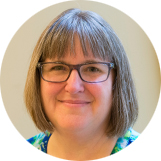
Kristin Fontichiaro
—
Clinical Assistant Professor,
University of Michigan School of Information

Limor Fried
—
Founder,
Adafruit
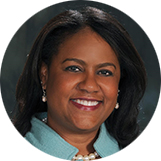
Yvette Morrison
—
Vice President of Marketing,
Snap-On Incorporated
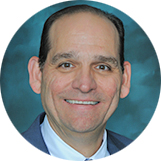
Bart Rocco
—
Superintendent,
Elizabeth Forward School District

Ahmad Shawwal
—
Student,
Univerity of Virginia
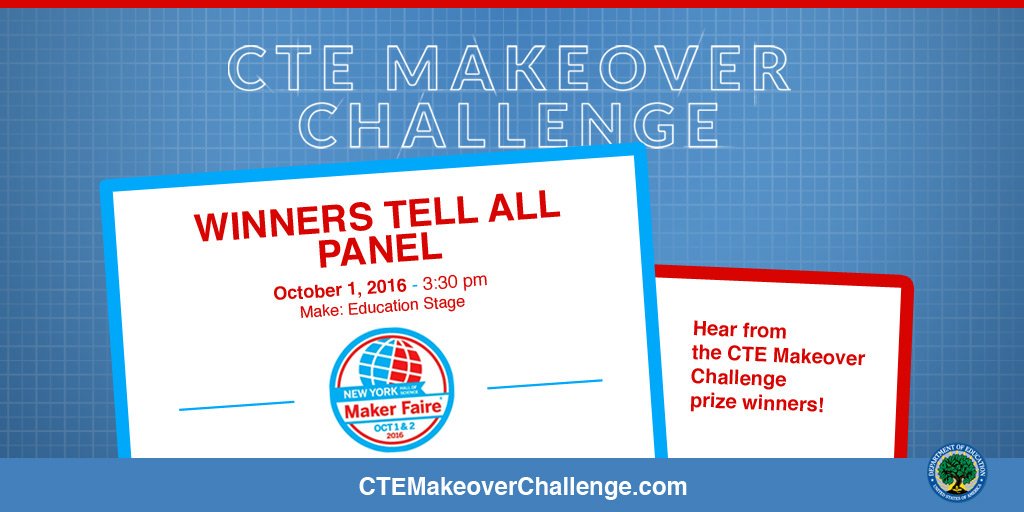
World Maker Faire Day 2
October, 2016
During a “Winners Tell All” Panel at Day 2 of the World Maker Faire, CTE Makeover prize winners shared how they brought their own makerspaces to life over the course of the Challenge. The prize winners also offered practical advice on how they secured early buy-in from administrators and school leaders to grow their maker programs.
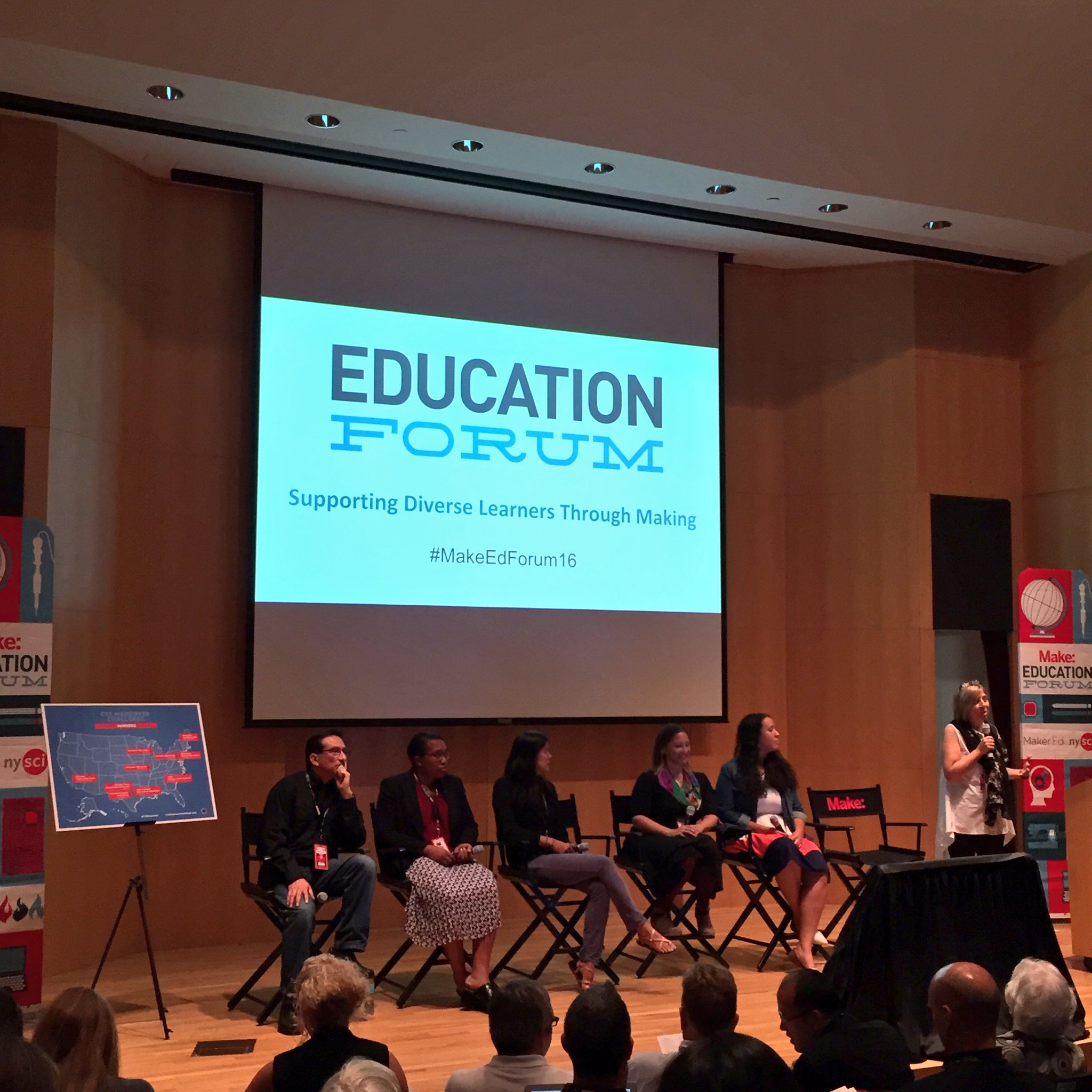
World Maker Faire Day 1
September 30, 2016
During a “Supporting Diverse Learners through Making” Panel at the Make: Education Forum Day 1 of the World Maker Faire, Albert Palacios, Office of Career, Technical, and Adult Education at the U.S. Department of Education, showed video tours from the winners and discussed how maker education supports diverse learning needs alongside a panel of esteemed speakers.
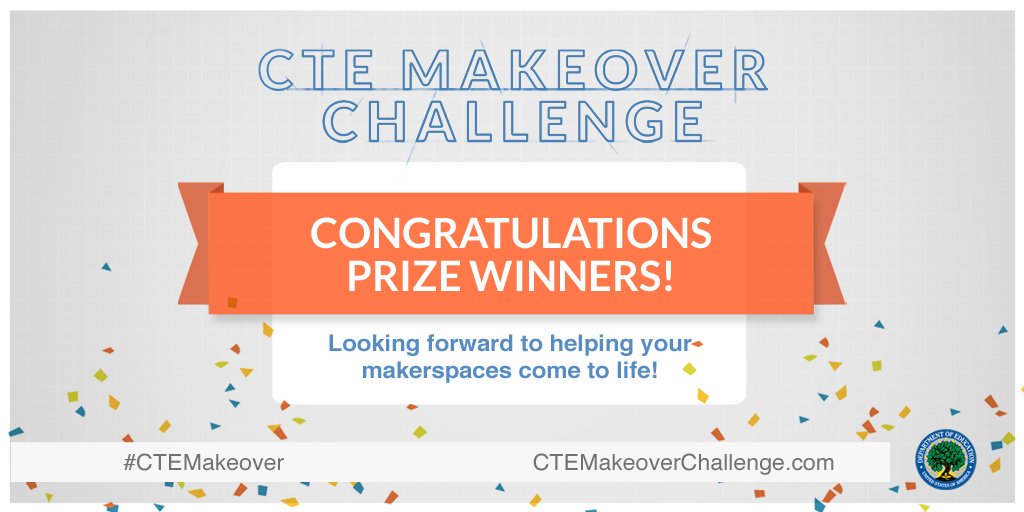
Winner Announcement
June 17, 2016
The 10 CTE Makeover Challenge prize winners were announced at the White House Champions of Change for Making event. Over 640 schools from all 50 states and Washington, D.C. entered the Challenge. Each winning school received $20,000 and a share of in-kind prizes donated by sponsors and valued at $375,000.
Six-week Bootcamp
April 11 - May 22, 2016
The six-week CTE Makeover Bootcamp was designed to help schools realize their vision for a makerspace. In addition to lesson plans and recorded webinars, schools had the option to participate in live, virtual group office hours to ask questions, and had access to communications toolkits and teacher guides to support the experience.
Info Session Webinar
March 17, 2016
Following the Challenge launch, a live webinar covered several key topics, including an in-depth overview of the Challenge structure, criteria, and timeline. The webinar concluded with a Q&A session. A complete transcript of the Q&A session is here (PDF).

Open Submissions
March 9 - April 1, 2016
The Challenge was first announced at the 2015 White House Maker Faire and submissions opened in March 2016. Schools interested in participating submitted their first round submission consisting of school details and makerspace goals, and following the close of submissions, all eligible schools gained access to the virtual CTE Makeover Bootcamp.
List of Sponsors
Autodesk
DonorsChoose.org
Dremel
Etsy Manufacturing
LEGO Education
littleBits
Maker Ed
MakerBot
Makerspaces.com
Makey Makey
Microsoft
Mozilla Foundation
National Coalition of Certification Centers (NC3)
Printrbot
Shapeways.com
ShopBot
Snap-on Incorporated
SparkFun
Teaching Institute for Excellence in STEM (TIES)
Fab Foundation
U.S. Fab Lab Network
Prizes Included
Equipment
- 20 Printrbot Play 3D printers
- 10 Dremel 3D Idea Builder printers
- Ul-certified for safety
- 4 MakerBot Replicator 5th Generation printers
- 2 Handibot portable CNC tools
- $15,000 in credits toward the purchase of a CNC machine
Tools & Supplies
- 10 Autodesk/Arduino Basic Kits
- 30 Microsoft Internet of Things Packs for Raspberry Pi 2
- 10 LEGO® MINDSTORMS® Education EV3 Core Sets with Software Packs
- 2 littleBits Workshop Sets
- 125 CTE Kits
- 5 Maker Ed “Possibility Boxes” (containing supplies and technologies for makerspace projects)
- 180 Makey Makey Classics
- Customized Snap-on roll cab tool boxes with a variety of essential tools for any makerspace
Mentors & Access
- 5 Hours of individualized consulting from Maker Ed
- 40 Hours of U.S. Fab Lab Network professional development training
- 10 Hours of Autodesk phone support
- One-on-one mentoring with Makerspaces.com
- Full day of in-person hardware training with SparkFun for 5 honorees
- Virtual professional hardware training with SparkFun for 5 honorees
- In-person ShopBot training
- 50 Hours of technical training from Microsoft
- Webinar and customized set of project suggestions with the Teaching Institute for Excellence in STEM (TIES)
- Two 20-hour Fab Foundation consultations for 2 of the honorees that have mobile makerspaces
- Beta access to Makey Makey in-person teacher training program
- National Coalition of Certification Centers (NC3) instructor training and certification
- Consulting and training from Snap-on and partners for designing and implementing new makerspaces
- Access to Snap-on’s image catalogue and assistance in producing makerspace signage and artwork
- Virtual or in-person tour with Etsy manufacturer
- 10 Instructables Pro Memberships (Autodesk)
- Access to Makerspaces.com training program for new makerspaces
Included below are the many readings and free resources that were made available to solvers entering the CTE Makeover Challenge, as well as the lesson materials offered during the six-week virtual bootcamp.
Use of these resources and tools was optional, but encouraged.
Bootcamp Lesson Plans
All eligible entrants to the CTE Makeover Challenge were invited to participate in the CTE Makeover Bootcamp (“Bootcamp”), a six-week program that provided instruction from experts, as well as suggested assignments, readings, resources, and office hours. The Bootcamp prepared participants to improve and expand upon their proposed makerspace concepts. At the completion of the CTE Makeover Bootcamp, eligible participants submitted a second round (“Blueprint”) submission that included detailed design plans, budgets, and implementation strategies.
Lessons included in the Bootcamp are described below, and a downloadable PDF of all lesson plans is available here and recorded webinars are available on the CTE Makeover Bootcamp YouTube playlist here.
LESSONS
- Lesson 0: Orientation and Overview
All entrants were required to participate in orientation and watch the orientation webinar in order to submit a Blueprint. - Lesson 1: Making and 21st Century Skills
Discover how making can strengthen skills that will allow students to succeed in the 21st century economy. - Lesson 2: Learning through Doing
Explore the topics and skills that can be taught using makerspaces and the projects, tools, and materials needed. - Lesson 3: Plan It, Make It
Draft the design, identify the right tools, and plan how you will construct your makerspace. - Lesson 4: Identifying and Engaging Your Community
Consider how your community can contribute to building and sustaining your makerspace. - Lesson 5: Budgeting and Resources
Make your plans a reality by drafting a budget and coming up with ways to gather the resources you will need to build a sustainable makerspace.
Additional Resources & Readings
RESOURCES
- Maker Ed Resource Library, Maker Ed
- Maker Ed Community, Maker Ed
- MakerED Resources for School MakerSpaces, Makerspaces.com
- Make: Magazine, Maker Media
- Maker Media
- Maker Education, Edutopia
- Maker Promise, Digital Promise
READINGS
- So You Want a Makerspace?, Artisan's Asylum
- Maker Club Playbook, Young Makers Program
- Career Clusters, Advance CTE
- A Nation of Makers, Whitehouse.gov
List of Participating Schools
Schools from all 50 states and Washington D.C. entered the Challenge in April 2016 by submitting their preliminary makerspace plans. Please see a list of all eligible schools that participated here (PDF).
DISCLAIMER
This website contains information and resources from public and private organizations that may be useful to the reader. Inclusion of this information does not constitute an endorsement by the U.S. Department of Education (ED) of any products or services offered or views expressed. Blog articles provide insights on the activities of schools, programs, grantees, and other education stakeholders to promote continuing discussion of educational innovation and reform. Blog articles do not endorse any educational product, service, curriculum, or pedagogy.
This website also contains hyperlinks and URLs created and maintained by outside organizations, which are provided for the reader’s convenience. ED is not responsible for the accuracy of the information contained therein.